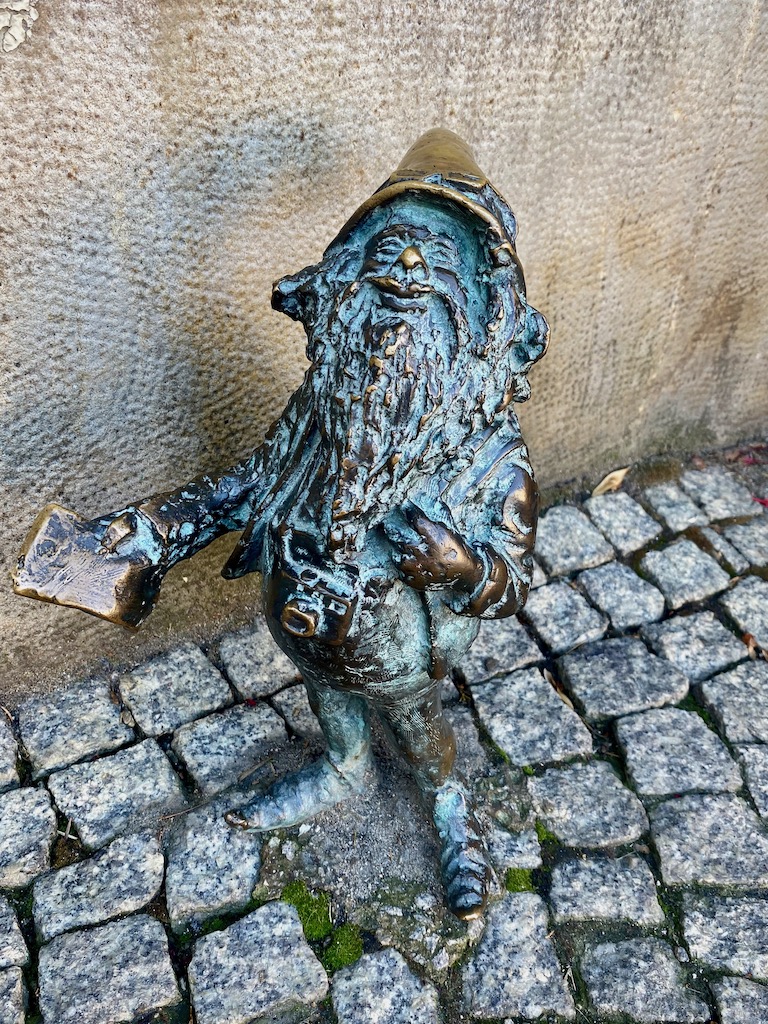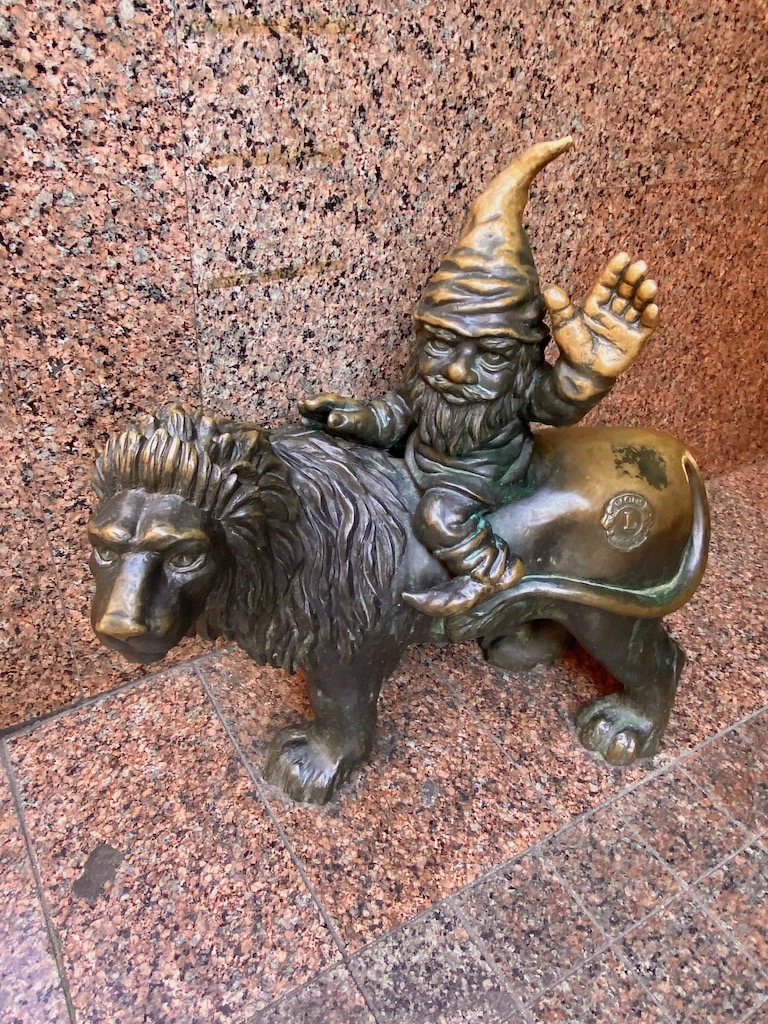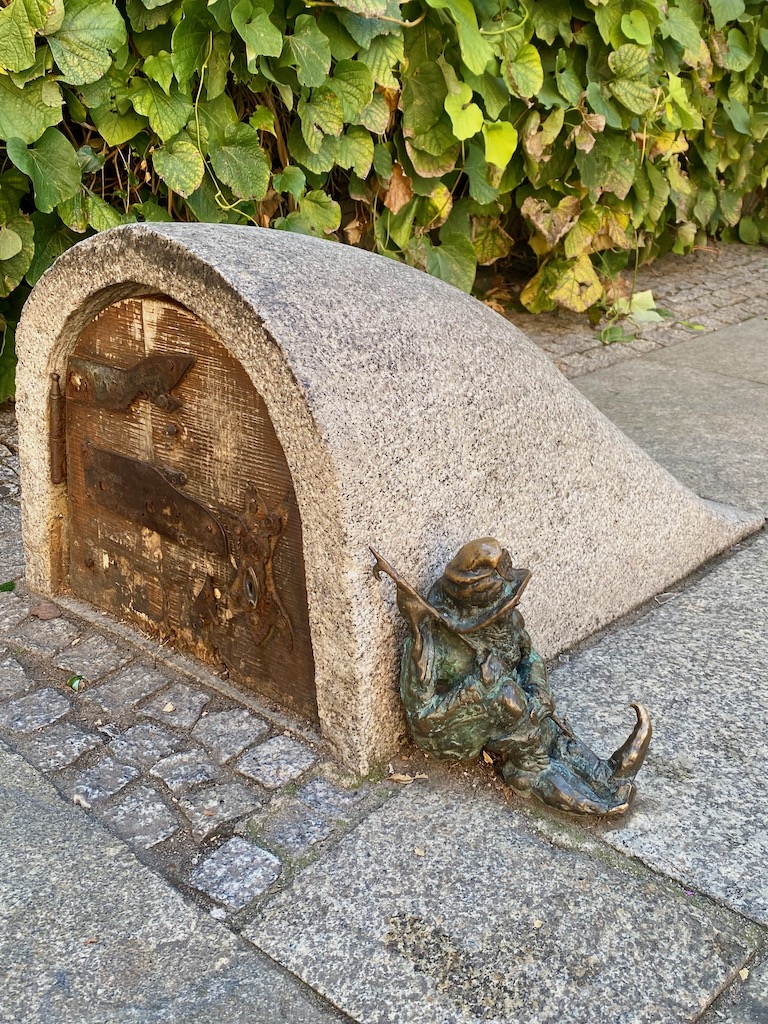Another two days of discoveries. I really like it.
We planned to visit Wrocław, the “Polish Venice,” built around the Oder River and its effluents. The city is charming; it has 127 bridges connecting 12 islands, a magnificent square surrounded by Renaissance-style mansions in pastel colors, and scattered tiny figures.
The Polish people call them “krasnales.“
They appear sitting on a bench, bustling about at the foot of a wall, eating ice cream, or reading the newspaper.
Do you want to know who they are?
Krasnales are goblins or gnomes, some little statues dotted around the city streets. No one knows precisely their number; some say there are, however, more than 300.




If you are curious and want to know more about these little guys, it’s here.
Here we go for the visit
Well, our weekend is off to a bad start. As often, we had booked a “free-walking-tour,” but our guide apparently did not get up on time! As the meeting point was on the famous market square next to the tourist office, we were able to organize our own tour aided by the tourist office.


The market square
We started our tour by the beautiful square in Wrocław. Like many cities in Poland, Wrocław was utterly destroyed during the war and rebuilt identically. We found ourselves transported once again to the past, to the Middle Ages.
The first markets took shape here at the beginning of the 13th Century. There were all the necessities, as well as craftsmen, shoemakers, or tailors.
The surrounding streets have taken their names from these various trades. Szewska, Białoskórnicza, and Jatki streets were the headquarters of shoemakers, butchers, and meat and offal shops.
A large central square like this also served as a place for punishments


The Wrocław pillory was once the point where justice was held. The culprits were tied to it several hours before the sentence was carried out, ranging from flogging to beheading or amputation of one of the limbs. Today there is a reconstruction of a stone pillory dating from 1492 made in sandstone by the famous Saxon sculptor Preussey.
Over the years, residential houses began to appear around the square. It took one hundred years for the place to become that of today, surrounded by terraced houses all different from each other — a manner for their owners to display their wealth through them.
Each side of the place has been named
The most remarkable for me is definitely the one in the west, nicknamed “The side of the Seven Electors.”




Some houses also have their own names, often taken from their facades:
- “The House of the Seven Electors,” whose frescoes date from 1672,
- “Under the Blue Sun,”
- “Under the Golden Sun,”
- “The Polish Court,”
- or even “Under the Griffins.”




As for the other sides, they are called “The side of the Golden Cup,” “The Side of the Green Duck,” and “The Side of the Sweet’s Market or Vegetable Market.”


The adjacent square, called Wool Square in the Middle Ages, undoubtedly due to the nearby Cloth Hall, is now named Pigeons Square.
And yet, there weren’t many when we were there!
The Cloth Hall…


Also known as the House of Merchants, it was once home to the Merchants’ Chambers, where cloth and other valuable materials were traded.
Forty windowless rooms were located on either side of a 100-meter-long corridor.
… and its ghost
An old story goes that a cemetery existed between the market square and the Church of St. Elisabeth. Every night, the spirit of a dishonest cloth seller haunted the Cloth Hall to repeatedly measure the cloth as eternal punishment for scamming her customers. It was only after digging up the body and burning it that the ghost stopped haunting the place.
It’s time to continue our visit. We moved towards a magnificent red brick building. Considering its size and appearance, we can immediately tell this was an official building. Indeed, we are in front of the Old Town Hall.
The Old Town Hall of Wrocław
Began in the 13th Century, we were not surprised to learn that it took 250 years to complete this Gothic building. One can imagine the number of plan changes that must have occurred during this long period of time.




The first construction phase included a tower, the Conspiratory, an adjacent single-story structure with cellars, and the Burghers’ Hall. The place was not then intended for commercial use.
Then a floor was added to include the Council Room and the Aldermen’s Room, followed by the creation of an extension with the courtroom, the Great Hall, and the Treasury and Little Treasury.
The Conspiratory


This 66 m high tower supports a clock with five dials — four on the tower and one on the facade — which marks the quarter hours and the hours themselves.
Currently, the Old Town Hall is a branch of the Wrocław City Museum with an art museum exhibiting, among other things, kerosene lamps and busts of famous inhabitants.
The New Town Hall was built at the beginning of the 19th Century.
We have one last monument to admire before leaving the square. The Gothic Saint Elizabeth Church, built in the 14th Century.
Saint Elizabeth Church


From 1525 to 1946, Saint Elizabeth was the main Lutheran church in Breslau and Silesia and the main congregation of the Evangelical Church of Prussia in Breslau. The last sermon in German was delivered on June 30, 1946, the year the church was handed over to the military chaplaincy of the Polish Roman Catholic Church.
How come a church built for Catholics came to be under the control of the Lutheran church?
Simply because a playful priest held it…
The story takes place in 1525. Scultetus, the priest in charge of the church, was indeed a good man but he had a big problem: gambling. One day, he challenged the local Lutheran priest Henry Rybisz to a game of dice. As so often, the luck at the start that made him win a lot of money gradually ran out. Confident and without a single doubt, he placed all his winnings on a single roll of the dice and inevitably lost everything. His shrewd opponent then offered him a deal.
So that he could stay in the game and have one last chance to recoup his losses, he was asked to bet something priceless. Scultetus then decided to bet the ownership of the Church of Saint Elizabeth itself. You know the end of the story.
The church dominates the square and offers a panoramic view of the Old Town from its bell tower. With the blue sky and the sun shining that day, I knew we would enjoy the scenery.
The entrance to the tower is through a passage between two houses connected by an arch. Each one has a name: Hansel the Gothic and Gretel the Baroque — in Polish, Jaś and Małgosia.


The vault, which symbolizes a handshake, is the old door of the cemetery closed in 1733, then surrounded by modest houses inhabited by church chaplains.


We went through the door, admired a dwarf and his little house, and made our way to the tower.
The climb of the tower
It was originally 130 meters high, but following a fire that destroyed it and the church in 1976, it was rebuilt and now stands 91.5 meters high.
It may be lower but a bit high when you have to get to the top by stairs. We take our ticket and go on an assault.
I admit that I was not comfortable at the start. Imagine a spiral staircase with a central pillar of 20 cm in diameter, a step width that makes crossing with other people difficult, a low ceiling, and no clue to indicate your position during the ascent.


It felt claustrophobic so I started counting the steps, but I gave up along the way due to it being really, really long.
However, the spectacular view soon made me forget the stressful climb.


We could admire the sharp sloping church roof with its brightly colored tiles and the city below.




After the descent that was, fortunately, far more straightforward, we continued our tour towards Ostrów Tumski Island, where it all began, which brings us to a bit of history.
Ostrów Tumski Island




Then it was the turn of the Saint John Baptist Cathedral to be erected, also in wood. It was not until the beginning of the 11th Century that buildings were constructed using solid materials.
The creation of the city is intimately linked to this island located between the branches of the Oder River. It was here that the first dwellings were built, the residence of the first duke, and the first wooden church, the Church of Saint Martin. Defensive walls surrounded it on the banks of the river. The island then had around 1,500 inhabitants.




We continued our discovery of the island until we found ourselves facing the magnificent Cathedral of Saint John the Baptist.






In 1315, Ostrów Tumski changed its status. The island was sold to the catholic church and served, among other things, as a place of sanctuary for those who had broken the law in Wrocław. An interesting peculiarity of the island was that it prohibited men from wearing any headdress — a law that also applied to royalty.
After strolling around the cathedral, we left the island and returned to the city center for our midday meal.
We spotted a milk bar and were in a hurry to feast on some good homemade Polish food.
If you’re new to milk bars, here’s some quick info.
One thing is for sure, they are not to be missed. It was not the case for us today. The line outside the door was too long, and our hunger too great. We, therefore, opted for a sandwich sitting on one of the benches in the square. I admit I was a little disappointed, but the good thing is that we didn’t waste any time at noon!
It’s time to head toward the University of Wrocław, its church, and its surprising statue.
Wrocław University


The main house of the Baroque-style university was built between 1728 and 1748.


On its southern facade, there is a balcony that supports the statues of Justice, Valor, Wisdom, and Moderation, as well as the mathematical tower crowned with a belvedere.




The impressive staircase leads to the Music Hall and the Leopoldine Hall on the first floor – a pearl of Wrocław Baroque.






The University Church




The sober exterior of the church contrasts with its interior rich in decoration. One can only be dazzled by the beauty of this church.








The statue of the Swordsman
The statue of this naked swordsman was erected in 1904. As we can see, the sword has been removed, but we can see its previous location in his right hand.
Besides being naked, the most epic thing is that the two nude women who support him seem to revere him.


Let me enlighten you.
The man is naked because this noble student lost even his clothes at a game one drunken evening. All he had left was his sword, a symbol of his nobility.
The four faces at his feet represent the lectures the student hated.
What about the naked women? I heard a confusing story about it, that the fencer resurrects the day a virgin student graduates with a master’s degree from this university. I don’t know what to think!
Of course, the role of such a sculpture was honorable. It was meant to serve as a warning to the students to keep them on the right track. Now, it is part of jokes and debates.
The butcher’s market
The old butcher’s stalls are the only medieval site preserved in Wrocław.




It was founded in the 13th Century and functioned for 700 years until the interwar period. Erected in honor of farm animals and inaugurated in 1997, the statues harmonize with the old and new uses of the street which are now lined with art shops.
Our day came to an end, and we were left with the feeling of joy as we returned to our hotel, which faces the sumptuous Wrocław Opera.




Around Wrocław


Our second day here was as beautiful as the first, and it was full of energy that we set off for our Sunday jog to explore Szczytnicki Park, 5 km from the city center.
It is where the Museum of Contemporary Art, the Centennial Hall, the Multimedia Fountain, and the Japanese Garden are located.
The weather was perfect, and we took in the still sleepy town and the banks of the Oder River with peaceful bliss.
Along the way, we were able to admire a few bridges…




… and had the good surprise of arriving in front of the fountain just as the musical jet show started.
A happy coincidence!
The Multimedia Fountain


It was created in 2009 to celebrate the 20th anniversary of the first free election in Poland after the war. The show lasts 20 minutes and takes place every hour from May to October, from 10:00 AM to 10:00 PM.
At night, music and water games are complemented by light shows.
The Museum of Contemporary Art and The Centenary Hall, the People’s Hall


The four-domed pavilion is part of the exhibition complex around the Centenary Hall created between 1911 and 1913 to celebrate the 100th anniversary of the victorious Battle of Prussia in Leipzig.
The Japanese Garden
It was created for the 1913 World’s Fair and restored at the turn of the 20th Century with the help of landscapers coming directly from Nagoya, Japan.








Our two days ended with this magnificent garden. There are other sights in this city. For example, I discovered that the city was full of stories, legends, sometimes strange, and sometimes the moral of which does not seem obvious to me. Here are two that left me thoughtful.
The Church of Mary Magdalene and the Penitents’ Bridge


This church is easily recognizable by its distinctive towers.


Unfortunately, you can’t see it in the photo — so you will need a little imagination — but a bridge connects the top of the two towers.
Long ago, legend has it that white figures with brooms walked along the bridge every night at dusk. They were the souls of girls who had attempted to escape domestic duty during their lifetimes and who were condemned forever to wander the bridge at night, cleaning it in their wake.
Of course, there is a more romantic note. The legend adds that if an unmarried couple walks along the bridge holding hands, their love for each other will never fade.
Another curiosity in Wrocław: The Egg Noodles Gate
First of all, noodles were already a popular dish in Poland.
But from there, to dedicate a door to them!


As my curiosity was once again piqued, we went to the Egg Noodles Gate.
Here is where Agnes and Konrad, a loving couple, lived long ago. Their life was simple; Konrad was a potter and Agnes regaled him with delicious egg noodles. But unfortunately, Agnes fell ill and died a few days later, leaving her husband all alone and desperately longing for her.
The story could have ended there had Konrad known how to cook, but he was incapable of it. Despite the dishes the neighborhood women brought him, he yearned for his late wife’s noodles and could not swallow anything else.
One evening when he fell asleep half-starved on the side of the road, he had a dream in which his beloved handed him a bowl of mouth-watering noodles. She gave him a stark warning not to eat it all and to always leave one noodle so the bowl can magically fill up for the next day.
And what had to happen happened. When he awoke to find the steaming bowl next to him, he couldn’t bring himself to stop and grabbed the last noodle to devour it — it must surely be the best!
But the noodle managed to slip out of his hands and fell on top of the portal next to him.
How? No one knows. Let’s not forget that it is a legend.
That said, Konrad was determined to finish it. So he climbed the barrier, and when he was ready to seize the last noodle, it turned into stone and Konrad returned empty-handed. As Agnes had warned, his bowl never refilled.
One can still see the stoned noodle at the top of the grill.
Please don’t ask me for the moral of the story! I have my little idea, but I don’t think it’s valid.
Final word
A gem of Poland.
Wrocław is part of the territories that were given back to Poland after World War II; it then belonged to Germany. Between 1945 and 1949, most of its non-Polish inhabitants were thereby expelled and traces of the German past erased. It is perhaps her story that led her to fight for her independence. It is the headquarters of the underground anti-communist organizations, Fighting Solidarity and Orange Alternative.
And what about the tradition of the dwarves present in every corner of the city?
And the unlikely legends about Wrocław add to the list of what makes it so appealing.
It is also a city of magnificent buildings, active and lively — so pleasant to walk around.
We only spent two days here, and we did not have time to stroll further through the small alleys of the historic center or along its pedestrian avenues, which we would’ve loved to do.
It’s a popular destination for tourists, and I completely understand why.
A stop to include in a trip to Poland, without hesitation!


